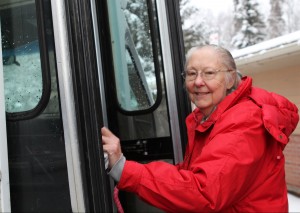
The number of people with Alzheimer’s disease in Alaska is expected to increase by more than 70 percent in the next decade. That’s because people are living longer and seniors are staying in the state instead of moving out. People with severe memory loss and their caregivers require more services, like Daybreak, a day-time activity center in South Anchorage.
Seventy-seven-year-old Vivian Cole walks laps around the second floor of the Diamond Center Mall, music blaring from a nearby store. Her conversation touches on some topics over and over — her children, fearing the snow, and her years living in Moose Pass.
“Loved it down there,” she says of Moose Pass and her home near a local bar and restaurant. “But that was years ago. My kids were… little.”
Cole has severe memory loss and can’t spend the day alone. While her daughter works, she participates in programs with Daybreak, an activity center that cares for adults who have Alzheimer’s disease and severe memory loss. The idea behind the center is to keep people active and to provide some respite for their caregivers.
“‘Without Daybreak, I could not have a job,'” quotes Liz Hunt, the director of the center, from a comment made by a caregiver.
Hunt explains that Daybreak is for people in the middle stage of Alzheimer’s. For the first seven years of the disease, people can usually function independently, so long as they can follow a list of reminders. For the next seven years, they can’t be left alone for long periods.
“They need somebody to say ‘Hey, it’s time for us to stand up, we’ve been sitting for a while.’ Or ‘I want us to do this activity together and I need your help, so come with me.’ And then the person will join in.”
Hunt says they follow a regular schedule: social activities and exercise in the morning, like walking at the mall. Some solo activities or listening to music after lunch. But she says the programs offered at Daybreak and around the state won’t be enough as the senior population explodes.
“I think we need to be ahead of the curve. We know these statistics. We know this is coming. We should put in the infrastructure to care for our seniors. That includes looking at all avenues. Do we need more adult day, do we need more in-home services? Do we need to look at what types of benefits seniors are eligible for? Transportation is a big issue.”
Not being able to drive was a major conversation point when a group of Daybreak clients sat down to talk about aging. It’s that loss of independence more than a loss of memory that characterizes aging for 80-year-old Bunny Williams. She says she came up to Alaska to visit her daughter, and her daughter wouldn’t let her go back home.
“When you get older, you think you can still do all these things. But you can’t,” Williams says. “But you don’t want to admit that to yourself, so they admit it for you.”
For her, the memory loss is just frustrating.
“You feel like you’ve lost your marbles, sometimes. And I was a school teacher with a college degree, and I can’t remember where I’ve left my dress.”
But some things she’ll never forget, like the story of her birth. She came prematurely and weighed only two and a half pounds. The doctor had to give her mouth to mouth.
“My dad called me his little bunny because I was so tiny, and it stuck! Here’s this big person still being called Bunny. But even my teachers at school did not know my real name unless they looked at the permanent record card because everybody called me Bunny.”
It’s the third time she’s shared the story that day, but it still sounds fresh and energetic. And for the record, her real name is Eleanor Rose.
Anne Hillman is the healthy communities editor at Alaska Public Media and a host of Hometown, Alaska. Reach her at ahillman@alaskapublic.org. Read more about Anne here.





